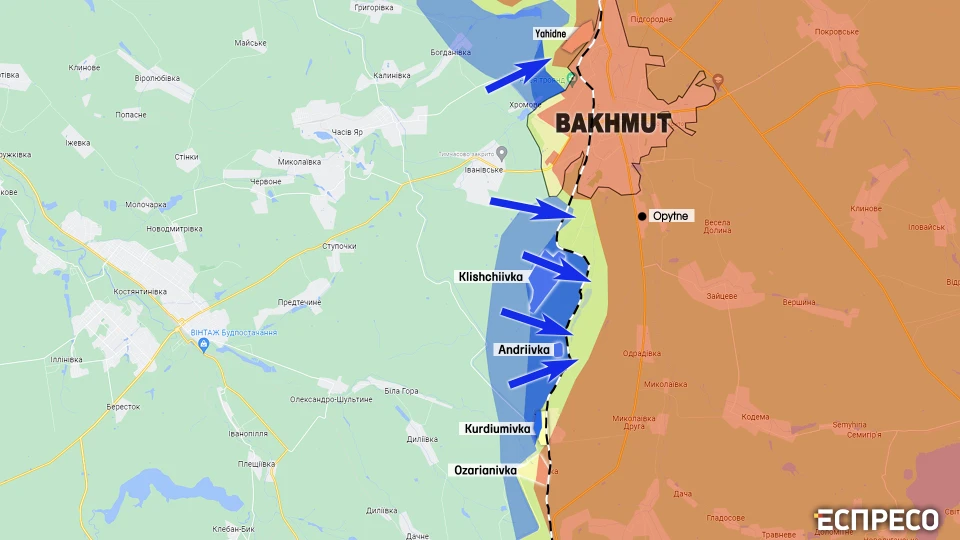
Ukraine gains ground south of Bakhmut – military expert Serhiy Zgurets
The Ukrainian sweep appears to be effective, but we're awaiting confirmation from the General Staff. The enemy is attempting to regroup and re-enter Klishchiivka, where our artillery inflicted heavy casualties on Russian forces
Frontline situation
Ukrainian forces are making progress in the Bakhmut and Tokmak areas, while the enemy is struggling to advance in different spots along the Kupyansk - Svatove - Kreminna line. The center of conflict is around Bakhmut, where the Russian Federation is attempting to regain its position at any cost and counterattack Ukrainian units, despite suffering losses. There are some positive developments, notably the Russian Federation's movement on the flanks around Andriivka, near the railway and, in some places, behind the railway, which was a long-standing defensive line for the enemy. For the past two days, it has seemed like there's no enemy presence in Klishchiivka. Ukrainian efforts to clear the area are showing results, but we're awaiting an official report from the General Staff, as the enemy is trying to regroup and enter Klishchiivka, where Ukrainian artillery has already inflicted heavy casualties on Russian forces.

Zaporizhzhia direction
The primary focus is on the Zaporizhzhia front, where developments are occurring rapidly despite claims of slow progress. While there aren't significant changes on the front line, there are some important developments.
Our forces are advancing toward Tokmak and putting pressure on the enemy to the south of Robotyne, which was vacated by Russian Federation regiments on August 23. Our units are operating in multiple directions, particularly Novoprokopivka, situated along the southern road through Tokmak to Melitopol. However, heavily fortified positions lie beyond Novoprokopivka. In addition to the pressure on Novoprokopivka, our Defense Forces are active between Robotyne and Verbove, launching an attack on Verbove from the west. The Russian Federation is defending itself within forested areas, where they have prepared defensive positions and firing points. Our military personnel have described capturing forested regions as more challenging than breaching Wagner's lines and dragon's teeth fortifications. Near Verbove, our troops have encountered several areas with "pyramids." There's a video explaining these specific challenges.

Apart from advancing in three directions (Novoprokopivka, between Verbove and Robotyne, and towards Robotyne), our troops must also expand the front line. This is crucial because, in the event of a rapid advance, the enemy might attempt flanking maneuvers. Expanding the front line is as vital as pushing Russian forces out of settlements. Given the significant losses suffered by the enemy's 58th Army, the Russian Federation has deployed two paratrooper divisions to this area. They are digging in and trying to bolster their defense in front of Novoprokopivka while attempting to halt the advance of our troops. Every part of the front is of utmost importance.
The NATO Secretary General has noted that Ukrainians are gradually making progress by pushing back the Russians and navigating through fortified areas, including minefields. Supporting them is now crucial. These battles are tough, and there's no easy path to victory, but Ukrainians are advancing. Trusting their courage and military actions has led to results that foreign politicians and experts could not have foreseen. We are at a crucial stage now.
Section Kupyansk – Svatove – Kreminna
In the northeastern region, the situation in the Kupyansk - Svatove - Kreminna area remains concerning. The toughest battles are ongoing around Raihorodka and Kovalivka. Here, the enemy is attempting to establish a foothold on the right bank of the Zherebets River and across from Novoyehorivka, a position from which they were previously driven out. Despite their losses, the Russian Federation persists in trying to breach our defenses with assault units in armored vehicles, but these efforts have proven futile. It's worth noting the situation in Synkivka near Kupyansk, where the enemy made prolonged attacks. However, they have now been pushed back considerably from Synkivka. Ukrainian brigades have been deployed in this area, despite Russian propaganda claiming Russian forces had occupied Synkivka and were advancing toward Kupyansk. In reality, Kupyansk is under the strong protection of the Armed Forces.
Syrskyi reports that the enemy is attempting to send reinforcements, often from Russia, as their units either cross the border to bolster or replace those that Ukraine has destroyed. This part of the front serves as a distraction, as the Russians hope to draw our units away from Bakhmut or the south. Presently, this isn't happening because the brigades in the south and near Bakhmut have the strength to handle the challenges on the Kupyansk - Svatove - Kreminna section. However, this area remains as challenging as any other, and all fronts are interconnected. The Armed Forces have a critical mission, primarily ensuring progress in the south and addressing issues in temporarily occupied territories, which will set the stage for significant changes on the battlefield and future offensive actions.
Use of scrap metal from military equipment
Apart from the frontline battles, several other factors influence the situation and have repercussions in various military sectors. Currently, Russian military equipment is being systematically dismantled, with over 20,000 pieces converted into scrap metal. However, the utilization of this scrap metal is not straightforward due to bureaucratic and logistical challenges. The Ministry of Defense is actively working to address these issues.
Oleh Koval, the head of the office for alienation and disposal of military property, explained that the scrap is located in various places, often in remote or hard-to-reach areas, necessitating extra efforts for transportation. These operations are costly and require specialized knowledge and technical solutions. According to a 2023 directive, the scrap is now the property of the Ministry of Defense. Ferrous and non-ferrous metal scrap holds strategic importance for steel production, particularly in the production of specialized military and dual-purpose steels.
However, the utilization of alloy steel scrap is limited in Ukraine, with minimal demand and difficulty in selling it at competitive prices, despite its high production cost. Although there is foreign demand, Ukrainian law prohibits the export of scrap metal. In the EU market, scrap metal can fetch 250 to 300 euros per ton, but in Ukraine, it cannot be sold for such amounts.
To address these challenges, the Ministry of Defense, in collaboration with experts and scientific institutions, has established a working group at the Chamber of Commerce and Industry. This group has developed a comprehensive plan for handling military scrap, encompassing four stages, including effective scrap management, processing, military product manufacturing, and job creation, particularly for veterans. The Ministry of Defense is also advocating for legislative changes regarding scrap metal handling, including inclusion in the Prozorro system and adjustments to internal documents, as well as proposals for export.
If successful, these efforts could yield significant benefits, including annual revenues of 2.5-3 billion UAH from the budget (plus foreign exchange gains) and the possibility of attracting foreign investments totaling 3.5-4 billion euros for processing facilities, which could create around 2,000 jobs, with a priority for veterans. Furthermore, these initiatives consider the vital aspect of addressing environmental consequences, which are immeasurable.
Production of Western weapons in Ukraine
President Zelenskyy has held a meeting with the leadership of BAE Systems, a major international arms manufacturer. They have decided to establish a representative office in Ukraine, focusing on weapon repairs and new projects. BAE Systems is renowned for its artillery systems and howitzers, which could benefit Ukraine. However, their collaboration extends beyond this, with involvement in the production of CV90 IFVs (armored vehicles).
The President referred to these IFVs, which Ukraine aims to manufacture domestically. Initially, there's a plan to purchase at least 1,000 of these vehicles. To realize this, Ukraine needs partnerships with companies that control crucial components for IFV production. BAE Systems is expected to be one of many companies establishing a presence in Ukraine, expanding capabilities for creating new weaponry.
Currently, Ukraine is in a dynamic phase where numerous companies view Ukraine as a promising market for their equipment. It's crucial for Ukraine to establish effective forms of cooperation to protect its defense industry and leverage partnerships with foreign entities.
Rheinmetall, for instance, has also decided to open a facility in Ukraine for armored vehicle repairs and production. This initiative begins with armored personnel carriers and eventually moves to manufacture Panther tanks with 130 mm guns. For this venture, Rheinmetall requires cooperation with Krauss-Maffei Wegmann, which manufactures the Leopard tank chassis. Germany supports this development in Ukraine.
Furthermore, there are ongoing negotiations with Turkish company Baykar to open a plant in Ukraine for the production of drones and more advanced models. This period offers Ukraine the opportunity to expand collaboration with international partners, strengthen its defense industry, find reliable allies, and fulfill G7 promises of long-term assistance in weapons creation and supply.
The key is to transform these opportunities into a sustainable business framework that supports the Defense Forces both now and in the future, exemplified by President Zelenskyy's meeting with BAE Systems and the decision to establish an office and enterprise in Ukraine.
- News













































